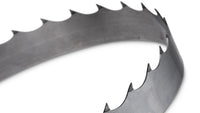Whether you’re cutting hard or softwood, a sharp blade is essential to produce high-quality lumber on your Frontier Sawmill. A sharp blade also cuts with less effort meaning less strain for you and your sawmill’s engine.
For optimal performance of a standard carbon blade, it's recommended to sharpen the blade profile approximately every two hours of cutting time. We advise honing the blade tips to maintain their sharpness rather than grinding a dull blade to reshape the edge.
Sawyers who don’t use a sharpener are most likely using a new blade to replace their dull blade every time, which is wasteful and unnecessary since blades can be sharpened multiple times over their lifespan. There are also sharpening services where you can send your blades to have them sharpened and reset for less than it costs to purchase a new blade. Note that not every community or area has these services.
Wear and tear resulting from regular use is a natural part of the life span of a band blade, which are subject to high physical loads on a daily basis. Visually inspect a blade for signs of stress, cracks in the metal, heavy wear, or damage to determine if it is safe to put back on the sawmill. When the metal gets fatigued and visible cracks are seen in the gullet, this is a serious sign to retire the blade. Tooth breakage will quickly put an unnatural end to a band blade and can happen at any point in the blade’s life. Damaged or broken teeth often result from striking a foreign object such as a rock or nail.
The number of teeth and the angle at which they are offset is referred to as tooth set. Tooth set affects cutting efficiency, and quality of the cut. Sawmill band blades typically follow a Raker three tooth pattern with a uniform set distance left and right, and a third straight “raker” tooth.
Every bandsaw blade needs to have the teeth set to produce material with a high-quality surface and effectively remove the sawdust from the milled log. A new blade will come with the manufacturer’s recommended set; however, with regular use teeth naturally lose their set, or flatten, over time, which reduces blade efficiency. When the blade strikes a nail or other foreign object if the teeth are not broken off, they will be knocked out of set. Poor set can cause the blade to dive/climb or produce wavy or scored boards and even generate excessive heat due to poor sawdust ejection, leading to premature failure or breakage.
